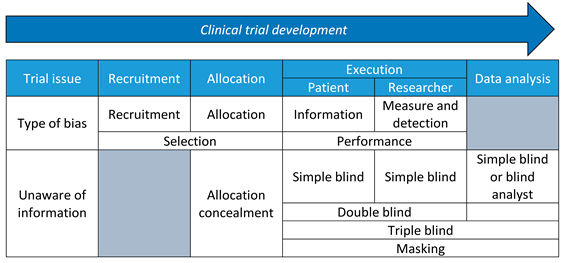Letters to the editor
← vista completaPublished on December 31, 2015 | http://doi.org/10.5867/medwave.2015.11.6349
Bias control in clinical trials: masking or blinding
Control de sesgos en los ensayos clínicos: enmascaramiento o cegamiento
Dear editor:
Clinical trials are prospective studies that, due to their design, allow proving causal hypotheses, where the impartial participation of their protagonists (patients, evaluators, data analysts, etcetera) is a key process in order to accomplish the proposed design and its main strength, internal validity. This latter issue is based on randomization and allocation concealment to the intervention or control group. These concepts, derived from anglicisms, cause doubts about the way they should be understood in Spanish, a fact that generates confusion at the time of t the study interpretation.
Is it the same randomization than allocation concealment?
Randomization is the process through which a patient is assigned, at random, to an intervention, after being recruited; while the allocation concealment (e.g. opaque envelopes, numbered containers, etcetera) is the method used after randomization, in order to avoid people involved in the study lose the impartiality of their participation (Table 1) [1].

Table 1: Processes of bias control at clinical trials
Masking or blinding?
Blinding at its original definition, refers to the act of depriving a person from vision [1]. In clinical trials, blinding refers to the process of concealment or cover up of information to any of the protagonists involved, classified in simple, double or triple, in function of the number of protagonists who don’t have the possibility to identify the group where the patient was assigned to (Table 1). On the other hand, masking has been understood for a long time as the fact to conceal, through a disguise the type of intervention received (e.g. drugs with the same characteristics, taste, color, etcetera); nevertheless, for many authors and specialized entities on clinical trials (clinicaltrials.gov, Cochrane Collaboration), both terms refer to the same issue [1],[2],[3],[4],[5].
Therefore, we consider that the adequate comprenhension of blinding and masking is relevant for their correct aplication, which will let to accomplish the methodology of clinical trials with high quality from its planning to its interpretation. Likewise, it is important to standardize the use of thiese terms for the purpose of avoiding confusion among Latinamerican and Spanish speaking researchers.
Notes
From the editor
The authors originally submitted this article in Spanish and subsequently translated it into English. The Journal has not copyedited this version.
Conflicts of interests
The authors declare not having any conflict of interests with the matter dealt with in this letter.
Funding
The authors declare not having received any financial support for this letter.

